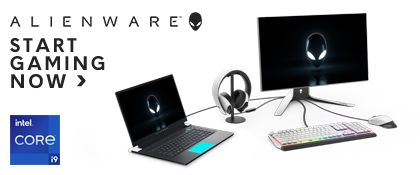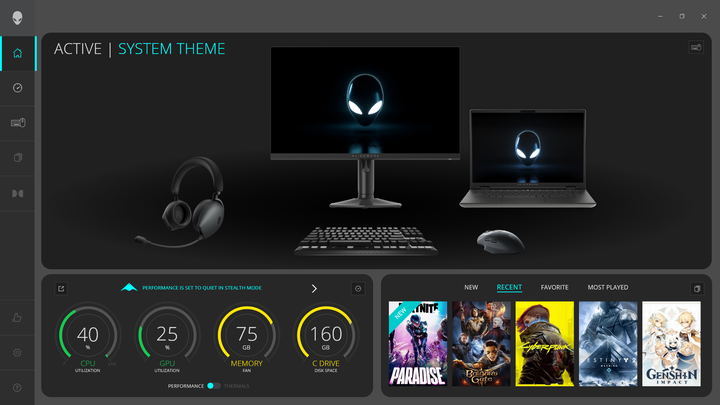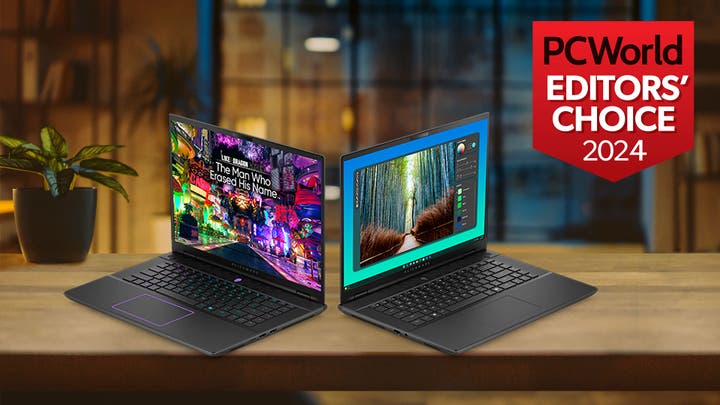The Alienware m15 R7 AMD pairs peak graphics horsepower with AMD’s Ryzen 6000 APUs
Sponsored by Alienware
Last year’s Alienware m15 Ryzen Edition R5 wowed gamers with high-end graphics performance and the celebrated battery life of AMD’s Ryzen 5000-series APUs. The new Alienware m15 R7 AMD takes that foundation and improves upon it with the latest Ryzen 6000-series processors, faster graphics options, room for more memory, more storage, and Advanced Optimus technology on every available panel.
Look closely enough and you’ll notice that the m15 R7 AMD and m15 R7 (with Intel’s 12th-gen Core CPUs) feature very similar specs. Alienware took customer feedback to heart this generation and built two evenly matched platforms that give enthusiasts the ultimate freedom in configuring their gaming laptops.
Alienware m15 R7 AMD: New and improved mobile hardware
Stepping up from the m15 Ryzen Edition R5 to m15 R7 AMD is an upgrade starting at the platform level. Alienware’s new model centers on AMD’s Ryzen 6000 mobile Accelerated Processing Units (APUs), which incorporate several significant enhancements compared to the Ryzen 5000 family.
Alienware offers the m15 R7 AMD with two top models: a Ryzen 7 6800H or Ryzen 9 6900HX. Zen 3+ architecture, smaller 6nm transistors, and an onboard RNDA 2-based GPU deliver up to 1.3x faster processing speeds and 2.1x faster graphics. Both APUs include eight cores able to work on 16 software threads at a time, plus 20MB of performance-enhancing cache. The 6800H boosts to clock rates up to 4.7GHz, while the 6900HX hits frequencies as high as 4.9GHz. While AMD gives these APUs a 45-watt thermal design power rating, the Ryzen 9 6900HX in my m15 R7 AMD sample held 60 watts throughout my most intensive CPU stress tests.
AMD also adds DDR5 memory support to the Ryzen 6000 APUs, moving more information at higher bandwidth to feed the chip’s cores. Alienware offers the m15 R7 AMD with 16GB, 32GB, or 64GB of DDR5-4800 in dual-module configurations, fully utilizing the Ryzen APU’s memory controller. Installing just one module cuts bandwidth to the Ryzen processor in half; by eliminating all single-module options, Alienware helps ensure every m15 R7 AMD achieves its performance potential. Enthusiasts get another nod in the form of two SO-DIMM slots that simplify memory upgrades.

The Alienware m15 R7 AMD Laptop in the Darkside color
These are AMD’s first mobile processors with PCI Express 4.0 connectivity, unlocking the full speed of current-generation GPUs and SSDs. Graphics and storage performance gets a boost, and the m15 R7 AMD's high-end hardware options get a bulky improvement. For the first time, it’s possible to pair an AMD-based platform with NVIDIA’s fastest graphics processor, the GeForce RTX 3080 Ti, and 16GB of GDDR6 memory.
Alienware offers the GeForce RTX 3070 Ti 8GB GDDR6, GeForce RTX 3060 6GB GDDR6, and GeForce RTX 3050 Ti 4GB GDDR6, matching the GPUs available with its Intel-based m15 R7. Both gaming laptops dedicate up to 140 watts of power to the GPU, putting both on equal footing for maximum gaming performance.
Whereas the m15 Ryzen Edition R5 shipped with up to 2TB of solid-state storage, the m15 R7 AMD doubles that with a 4TB option running at PCIe 4.0 speeds. My sample included Samsung’s PM9A1, rated for sequential reads up to 7000 MB/s and sequential writes up to 5200 MB/s.
Getting more power into a 15” form factor with upgraded Cryo-tech cooling.
The 140-watt graphics power rating is new to Alienware’s AMD-based m15 family. The m15 Ryzen Edition R5 I wrote about last year came with a 115-watt GeForce RTX 3070 GPU. NVIDIA’s Dynamic Boost 2.0 technology nudged it up to 125 watts when thermal headroom allowed. So, how does Alienware get extra power into the m15 R7 AMD while simultaneously keeping temperatures down? It improved this generation’s cooling to cope with the latest gaming hardware.
Specifically, configurations with NVIDIA’s GeForce RTX 3060 and higher include a pair of larger-diameter, thinner fans with up to 2.3x as many blades to the previous generation. They pull in 130% more ambient air than their predecessors and blow across core components that are 87% less obstructed.

A detailed look at the Alienware m15 R7 AMD laptop's new motherboard and fan system designed to optimize cooling.
With Advanced Optimus and G-SYNC on every panel, all gamers get a better experience.
The m15 R7 AMD comes with three display options: a 15.6” FHD panel with a 165Hz refresh rate, an FHD panel with a 360Hz refresh, and a QHD panel with a 240Hz refresh rate.
All three are great-- but if you’re into competitive gaming, stepping up to a 360Hz refresh rate will help smooth out animations, reduce ghosting, minimize system latency, and (hopefully) improve your response times.
Content creators benefit from higher resolutions. Beyond its 2560x1440 resolution, the QHD option covers 99% of the DCI-P3 color gamut. It shows more colors than either of the FHD panels rated for 100% of the sRGB gamut, which is exactly what you want for photography and video editing work.
Whether you opt for the standard 165Hz screen, the gamer-oriented 360Hz panel, or the spacious QHD display, all three options feature NVIDIA’s Advanced Optimus and G-SYNC technologies.

The Alienware m15 R7 AMD Laptop in the Darkside color
Advanced Optimus dynamically selects whether to drive your display with AMD’s integrated Radeon 680M or NVIDIA’s GeForce GPU depending on the application you’re running. When the discrete graphics processor isn’t needed, it powers down, extending the battery life of your gaming laptop. The GeForce chip automatical handles control when you launch a game, ensuring the best possible performance without restarting Windows or toggling a software switch.
Creating a dedicated link between the discrete GPU and panel allows support of NVIDIA-specific technologies like G-SYNC, where the display's refresh rate matches your game’s frame output rather than forcing the GeForce processor to output through the integrated graphics engine. This synchronization eliminates pesky artifacts like tearing and stuttering for a smoother gaming experience.
In the previous generation, only Alienware’s 360Hz FHD screen included G-SYNC support, so making Advanced Optimus and G-SYNC support universal on the m15 R7 AMD is a huge win for enthusiasts. Why? It’s all about the democratization of premium functionality. Advanced Optimus uses a hardware multiplexer (or MUX) to switch between GPUs, so it adds cost, but we’re glad to see Alienware make that investment on every version of this system.
Revisiting Alienware Command Center thermal profiles
The m15 Ryzen Edition R5 shipped with two thermal profile options in the Alienware Command Center: Full Speed and Balanced. These course adjustments either spun the fans at maximum duty cycle (for higher boost frequencies) or more conservatively (for a better acoustic experience).

Screen capture of the Alienware Command Center thermals panel
This time around, Command Center gives you a choice between 5 profiles for granular control:
- Full Speed
- Performance
- Balanced
- Quiet
- Battery Saver profiles
That said, there's more to each setting than just fan speeds.
To help you get the most from your m15 R7 AMD, I ran a series of stress tests using all five settings. Along the way, I logged telemetry data to illustrate power levels, clock rates, and temperatures.
Let’s start with a look at CPU behavior.
 |
CPU Power Prime95 5-Min Results (In Watts)
Using Prime95 as an extreme workload, the 45-watt Ryzen 9 6900HX APU averages 60 watts of package power regardless of the thermal profile you choose. This is known as the chip’s long-duration power limit.
It might come as a surprise that the m15 R7 AMD sustains these power levels, as the Quiet and Battery Saver settings barely spin its fans. You'd think if the m15 R7 AMD cools the APU well enough in those cases that the Performance or Full Speed profiles would have headroom for higher power. A closer look at the results shows that AMD’s Ryzen 9 6900HX does approach 80 watts at the start of my test—for only a few seconds—before dropping down to 60 watts. This brief burst of extra power, referred to as the APU’s short duration power limit, helps accelerate smaller workloads without stressing the m15 R7 AMD’s thermal solution.
Although higher power limits are possible with this APU, staying conservative pays dividends when we chart temperatures.
 |
CPU Temperature Prime95 5-Min Results (In Celsius)
Despite Prime95’s punishing workload, AMD’s Ryzen 9 6900HX gets no warmer than 90°C—and that’s using AWCC’s Quiet thermal profile. Cranking up fan speeds with the Full Speed profile drops the average to 82°C.
According to AMD, the Ryzen 9 6900HX has a maximum operating temperature of 95°C. The m15 R7 AMD operates well below that limit at any thermal profile setting you choose.
 |
GPU Power FurMark 5-Min Results (In Watts)
Alienware Command Center’s thermal profiles have a much more significant influence on the GeForce RTX 3080 Ti in my m15 R7 AMD sample.
If you want maximum graphics performance, the Full Speed setting taps into all 140 watts exposed by NVIDIA’s flagship mobile GPU. The Performance profile isn’t far behind, though, with an average just one watt short of Full Speed. Even the Balanced profile proves great for gaming, with a 134-watt average.
Running FurMark and imposing the Quiet or Battery Saver profiles is asking a lot from the m15 R7 AMD. Both settings are designed to reduce power in the interest of acoustics and longevity, respectively, which is why we see the average power drop to 115 watts (in the case of the Quiet profile) and 55 watts (from Battery Saver).
 |
GPU Temperature FurMark 5-Min Results (In Celsius)
Alienware’s Full Speed thermal profile moves so much air through its m15 R7 AMD that the GeForce RTX 3080 Ti reaches maximum power at just 79°C.
The Performance setting is more conservative with its airflow, only getting aggressive enough to touch peak power at the GPU’s thermal limit. By dialing back fan speed a bit, AWCC’s Balanced profile rides that same thermal boundary but is forced to reduce power slightly to duck under its ceiling.
The Quiet profile gives NVIDIA’s GPU as much power as possible at reduced fan speeds. In response, though, the GeForce RTX 3080 Ti gets warmer. Fortunately, using this setting while marathon gaming is an impractical proposition, even more so for the Battery Saver profile, which idles the GeForce to maximize battery life. As a result, the chip cools down substantially since it’s limited by clock rate rather than thermals.
 |
GPU Clock Rate FurMark 5-Min Results (In MHz)
FurMark is an intensive graphics workload. Some in the industry call it a “virus” for its ability to drive out-of-control thermal conditions. As a result, we don’t expect the GeForce RTX 3080 Ti to hit NVIDIA’s 1455MHz GPU Boost rating; it’s far more likely to reach that frequency in real-world games.
Nevertheless, by setting the Quiet profile’s 892MHz average as our 100% reference, we can compare each setting’s effect on clock rate using percentages. Clearly, bumping up fan speed has a positive effect on clock rate, culminating in the 1198MHz average we see running at Full Speed.
Putting Alienware’s m15 R7 AMD to the test
The sample I tested includes a Ryzen 9 6900HX APU (8C/16T, 45W), a NVIDIA GeForce RTX 3080 Ti 16GB GDDR6, 32GB of DDR5-4800 system memory, a 1TB Samsung PM9A1 NVMe-based SSD (x4 PCIe 4.0), and a 1920x1080 display with a maximum refresh rate of 360Hz.
While I no longer have access to last year's m15 Ryzen Edition R5, Dell handed me a collection of well-documented performance data for that model to compare to the m15 R7 AMD. I'll be using the Full Speed profile as a basis for comparison.
Its specifications include a Ryzen 9 5900HX APU (8C/16T, 45W), an NVIDIA GeForce RTX 3070 8GB GDDR6, 16GB of DDR4-3200 system memory, a 1TB Micron N30NY NVMe-based SSD (x4 PCIe 3.0), and a 1920x1080 display with a maximum refresh rate of 360Hz.
 |
UL 3DMark Time Spy Benchmark (In points)
Arming the m15 R7 AMD with flagship-class APUs and GPUs makes it a more formidable gaming laptop than the previous-generation m15 Ryzen Edition R5. Its Overall 3DMark Time Spy score is 16% higher. The GPU component of that rises by 17%, while improvements made to AMD’s Zen 3+-based Ryzen 9 6900HX contribute to a 13% speed-up.
 |
Cinebench R3 Advanced Benchmark (10:00 Runtime) (In CB)
Whereas 3DMark (mostly) reflects the m15 R7 AMD’s faster GPU, Cinebench R23 is exclusively affected by host processing performance.
A combination of architectural enhancements and a higher boost clock give the Ryzen 9 6900HX an almost 4% advantage over the m15 Ryzen Edition R5’s processor in Cinebench R23’s single-threaded test. That advantage grows to more than 6% in the Multi-Threaded benchmark.
 |
Game Performance 1920x1080 (In avg. FPS)
Between the m15 R7 AMD’s faster host processor and flagship-class GPU, it posts significantly higher average frame rates than the m15 Ryzen Edition R5 in all the games I compared to Dell’s benchmark results.
I deliberately ran tests that emphasized the highest quality settings. If you’re looking to get the most from this system’s 360Hz display, dial back the detail presets and you’ll see >200 FPS in some of these games. For reference, competitive esports titles run at even higher frame rates.
The m15 R7 AMD’s evolved design means better performance from higher-end hardware
Putting the m15 R7 AMD next to the m15 R7 with Intel’s Core i7-12700H, it's difficult to tell them apart. Now, put their spec sheets side-by-side: they’re available with the same GPUs, the same memory configurations, and the same storage capacities. Both laptops have the same three-panel options featuring NVIDIA Advanced Optimus and G-SYNC technologies with choices between three different keyboards, including the low-profile mechanical keyboard with CherryMX switches and per-key AlienFX lighting.
And that’s the point. As a gamer and hardware enthusiast, it’s great to see this generation’s Alienware m15 serve up equally powerful AMD and Intel platforms.

The Alienware m15 R7 AMD Laptop in the Darkside color
Improvements to Alienware’s Cryo-tech cooling technology are a rising tide that lifts both boats. By moving more air across less-obstructed components, the two m15 R7s can now deliver up to 170 watts to their CPUs and GPUs in a similarly sized 15” form factor. Based on my thermal and power measurements, those two subsystems have headroom to spare—even on an m15 R7 AMD with a Ryzen 9 6900HX and GeForce RTX 3080 Ti.
It didn’t escape me that the m15 R7 AMD can only be ordered with two DDR5-4800 memory modules—a deliberate decision according to sources inside the company (and largely based on customer input). Alienware also applied feedback about the previous generation’s storage. All models with GeForce RTX 3060 graphics and up support two SSDs. Systems built with one drive should include the assembly bracket, heat shield, and screw needed for the second drive. I confirmed this on my m15 R7 AMD sample. So, keep those comments coming. They make a difference.
You can find me on Alienware’s Discord server, generally hanging out in the #tech-talk channel under the username crazipper.
If you have questions about my experiences with the m15 R7 AMD, don’t hesitate to look me up. See you in the Discord!












